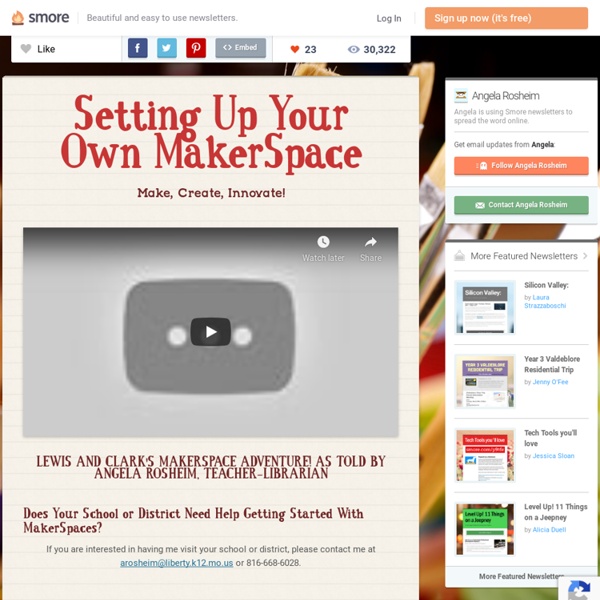The Makings of a Makerspace: Three Examples
In late October, 2013, I visited several makerspaces in the bay area crammed into one day, and blogged about my discoveries here. Then, in summer 2014, I visited two more makerspaces and blogged about those here. Most recently, the fabulous Jaymes Dec hosted me at Marymount in NYC, Kat Sauter hosted me at Ann Richards STARS in Austin (whom I also visited back in 2013 before their makerspace!), and Ross Monroe hosted me at Edmonds Community College here in Seattle. (This great post by the Tarrant Institute for Innovative Education at the University of Vermont also has some great ideas and examples for flexible physical learning environments.) Overall Organization
STEAM Project Recipes: Insta-Robots and Sewing Art
All photos courtesy of Todd Burleson Two STEAM project recipes from Todd Burleson, SLJ’s 2016 School Librarian of the Year and participant in Library Journal and SLJ’s four-week Maker Workshop, starting January 31. Insta-Robot
The Role Making Can Play in Education and Future Work – Classroom Aid
“American kids should be building rockets and robots, not taking standardized tests.” — By Dale Dougherty Learning by Making In this post “Learning by Making” published on Slate Magazine site, Dale elaborated: “Learning by doing” was the distillation of the learning philosophy of John Dewey. He wrote: “The school must represent present life—life as real and vital to the child as that which he carries on in the home, in the neighborhood, or on the playground.”
6 Strategies for Funding a Makerspace
1. Find or Repurpose a Space Finding a room is easier than you think.
Resources for Creating a Makerspace
Are you ready to create your own Makerspace? Would you like some help? The Makerspace Lab website is designed to provide teachers, technology directors, librarians, hacker space designer and community leaders with information on how to make a Makerspace. The Makerspace community is very generous, and provides a lot of free information about how to build a space, lessons learned and tips for running a Maker Space. The following list of links should get you started. Come back soon as we add more DIY information.
Making Space for a No-Frills Maker Space
Volume 3, Issue 4, Number 4 Driving Question: No Frills Maker Spaces: What? How?
Makerspace Starter Kit
The hot new Makerspace Movement is NOT new to Murray Hill Middle School. Eighteen years ago we designed and opened the school with the idea that we would have creation labs in the Media Center, GT room, and the TV studio. We started with video production, iMovie, Specular LogoMotion, Hyperstudio, and animation with Hollyood High kids. Here's an example of an EARLY (2003) video production called Bookfellas, featuring some Guy Ritchie-esque film direction techniques. These kids are now all grown up and we've kept evolving, too! It's OK to Start Small!
60+ Makerspace Ideas for Maker Education
FREE PDF – 100+ Makerspace Materials and Supplies Below is a growing collection of our favorite tweets that focus on makerspace ideas. These ideas range from how to get started to what maker project to do in your makerspace. Whenever we put something online or on Twitter, we want it to be actionable for the makerspace operator. We know you’re busy and we want to help simplify the process of starting and running a makerspace. Hopefully these ideas help!
6 Essential Tips for Designing Your Makerspace’s Layout
When planning a makerspace, most think about designing for creativity. It’s important to think about the types of projects that will be completed in the space, how many people will use the space at any given time, and the equipment on your must-have versus nice-to-have lists. However, there are also a few considerations that often go overlooked. Nansemond-Suffolk Academy, a fully-accredited private school serving students in pre-kindergarten through twelfth grade with two locations in Suffolk, Virginia Space Utilization – Design, Fabrication, or Both? It’s important to consider where lab users will be designing versus making.
A Thematic Approach to Planning Your Maker Space
When schools talk about the Maker Movement and creating maker spaces, they often focus their initial thinking on purchasing the tools and materials. This resource-driven approach can create a buzz in your school for some time; however, that excitement will inevitably fade. While resources are an important part of any maker space, taking a thematic planning approach is much more effective. No two maker spaces are alike or should be alike.
Makerspace Resources and Programming ideas
Create Collaborate Innovate Posts on Making Sign up for this MOOC offered by Exploratorium: Tinkering FundamentalsSign up for Google’s Maker Camp and Google Science Camp.Follow and read the blog over at Exploratorium’s Tinkering Studio or sign up for their tinkering course!Find cool stuff and Make it at your Library!Need ideas? Browse crowd-sourced projects over at Instructables!
Curious about classroom Makerspaces? Here's how to get started.
Makerspace is a rapidly growing trend in schools across the country, but to be honest, I’ve never implemented one myself, and I can’t quite picture the logistics of orchestrating a Makerspace. How do kids know what to do? How can you find out what they’re learning? How do you make time for that with all the other tasks crammed into the school day? And how do you keep the Makerspace from turning into a chaotic mess? I wanted to get answers to these questions from teachers who have extensive Makerspace experience, and not just at the secondary level.



